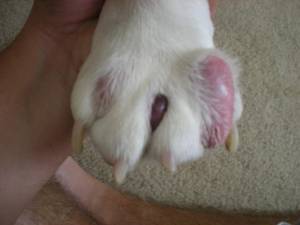There are several possible dangers associated with an infected paw in cats. Here are a few:
- Pain and discomfort: An infected paw can cause pain and discomfort for your cat, making it difficult for them to walk or put weight on the affected paw.
- Abscess formation: Infections can lead to the development of an abscess, which is a pocket of pus. Abscesses can be painful and require medical intervention, such as draining and antibiotic treatment.
- Spread of infection: If left untreated, an infected paw can lead to a systemic infection, spreading throughout the cat’s body. This can have serious consequences for the overall health of your cat.
- Difficulty grooming: Cats are meticulous groomers, but an infected paw may cause difficulty in grooming that area. This can lead to matting of the fur, skin irritation, and further complications.
- Secondary infections: In some cases, an infected paw can lead to secondary infections, such as cellulitis or osteomyelitis. These can be more severe and require more aggressive treatment.
Symptoms of an infected paw in cats

If a cat’s paw gets infected, it can lead to discomfort and pain for your beloved pet. It is crucial to be able to identify the signs of an infected paw to ensure timely treatment. Common indications of an infected paw in cats are as follows:
- Swelling and redness in the paw.
- The paw feels warm when touched.
- Walking with a limp or hesitating to bear weight on the injured paw.
- Excretions or pus emanating from the paw.
- When a dog consistently licks or bites its paw to a great extent.
Causes of paw infections in cats
There are several potential causes for paw infections in cats, including:
- Bacterial or fungal infections: These can occur if the paw is injured or if dirt and debris become trapped in a wound.
- Allergies: Some cats may develop paw infections as a result of allergies, which can cause itching and irritation.
- Foreign objects: If a cat steps on a sharp object or gets a splinter in their paw, it can lead to an infection.
How to treat an infected paw at home
While it’s always best to consult with a veterinarian for proper diagnosis and treatment, there are some steps you can take at home to help treat an infected paw in your cat:
- Keep the paw clean: Gently clean the affected paw with warm water and mild soap to remove any dirt or debris.
- Apply a topical antiseptic: After cleaning the paw, apply a pet-safe antiseptic ointment or spray to help prevent infection.
- Use a warm compress: If your cat allows it, you can apply a warm compress to the paw to help reduce swelling and promote healing.
- Monitor your cat’s activity: Encourage your cat to rest and avoid excessive activity to prevent further irritation to the paw.
When to seek veterinary attention
While home remedies may help alleviate mild cases of paw infections, it’s important to seek veterinary attention if:
- The infection does not improve within a couple of days
- The swelling or redness worsens
- Your cat is in severe pain or is unable to walk on the affected paw
- The infection is accompanied by other concerning symptoms, such as fever or loss of appetite
Prevention Measures
The key to protecting your cat’s paws from infections lies in prevention. Here are some tips to help prevent paw infections:
- Regularly examine your cat’s paws to identify any cuts, scratches, or foreign items.
- It is important to maintain cleanliness in the litter box as a dirty one can carry bacteria and cause paw infections. Make sure to clean the litter box on a regular basis.
- Ensure a hygienic surrounding: Maintain cleanliness and remove any clutter from your cat’s living space to prevent harm to their paws.
- Ensure that your cat’s nails are kept short, as long nails can result in your cat scratching their paws and potentially causing infections.
- Ensure that you utilize cleaning products that are safe for pets when tidying up your cat’s living space in order to prevent any potential harm from exposure to dangerous chemicals.
Common misconceptions about cat paw infections
There are a few common misconceptions about cat paw infections that are important to address:
- Paw infections can heal without intervention: Though small instances of paw infections may get better with self-care, it is crucial to consult a veterinarian for accurate identification and treatment.
- Cats do not have to go to the vet for paw infections: Since cats are experts at concealing indications of sickness or discomfort, it is advised to seek advice from a veterinarian to make sure the infection is treated correctly and to eliminate any possible underlying issues.
- Paw infections are not a trivial matter: They can cause discomfort for your cat and potentially result in complications if ignored. It is crucial to promptly attend to any indications of infection.
In order to keep your cat content and healthy, it is essential to understand the indications, causes, and treatment options for infections in their paws. If you suspect that your cat has a paw infection, it is vital to contact your veterinarian immediately for appropriate care and guidance. Your veterinarian will be able to suggest the most suitable treatment based on your cat’s specific needs.





